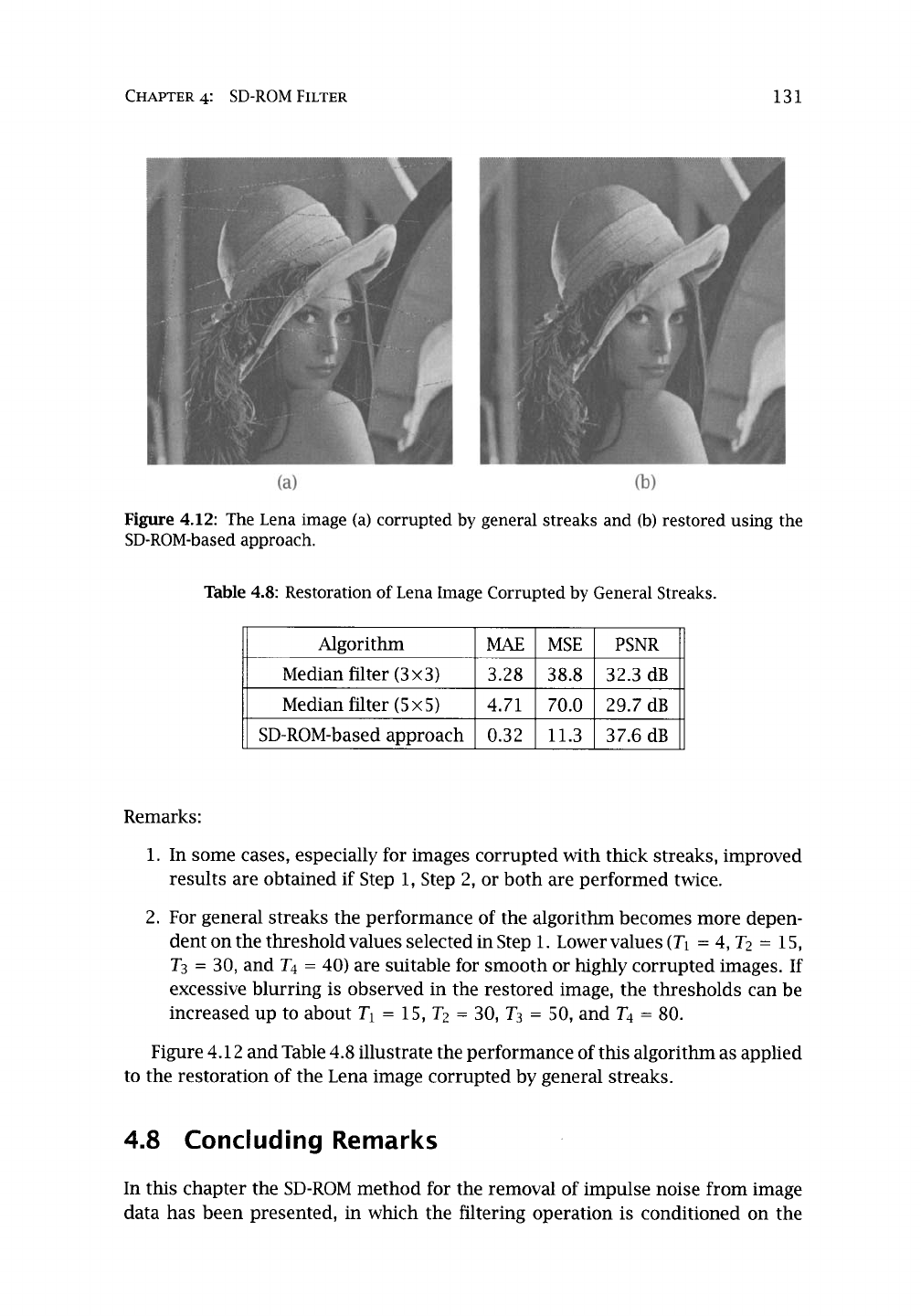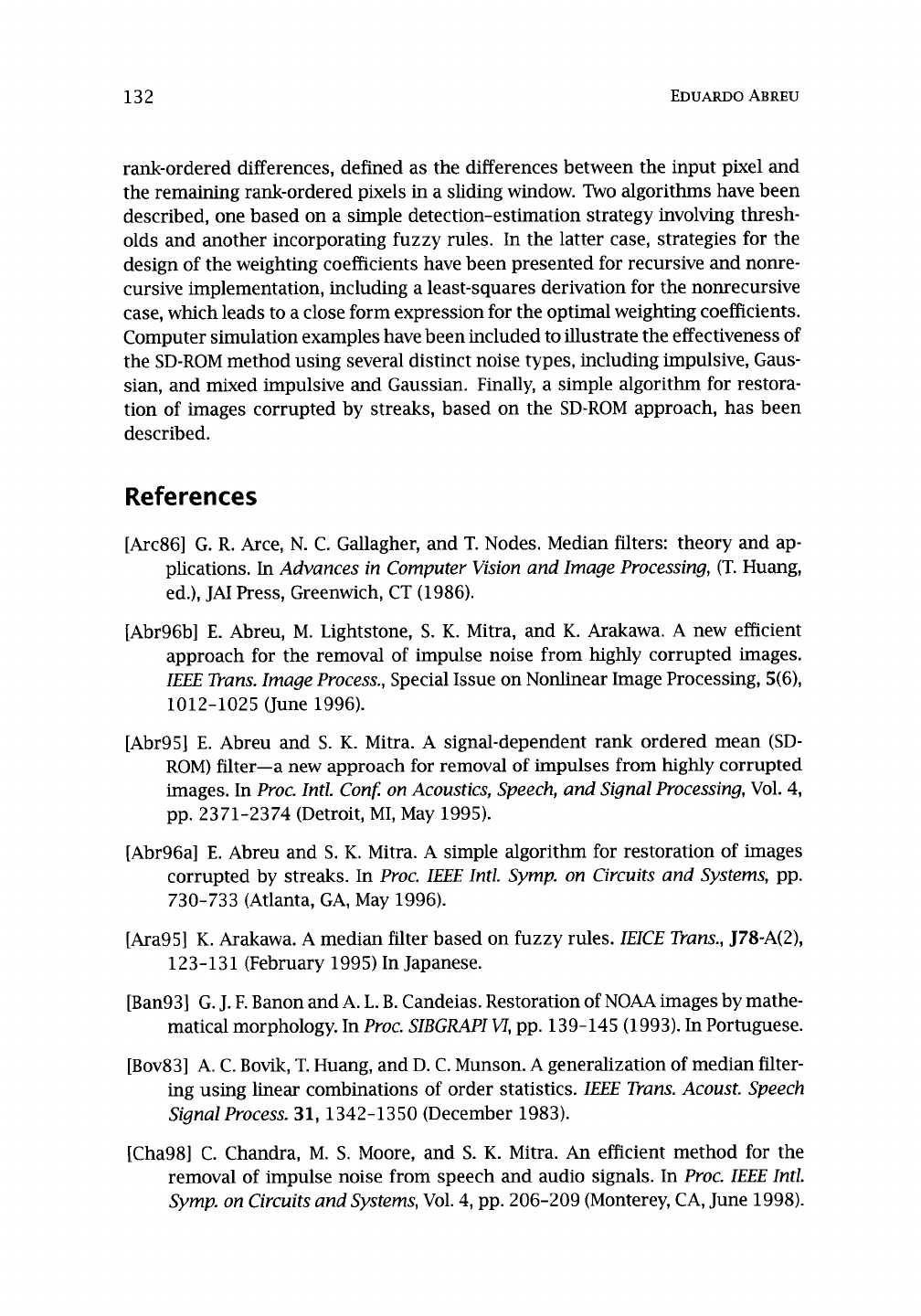
CHAPTER 4: SD-ROM FILTER 131
Figure 4.12" The Lena image (a) corrupted by general streaks and (b) restored using the
SD-ROM-based approach.
Table 4.8: Restoration of Lena Image Corrupted by General Streaks.
Algorithm MAE MSE PSNR
Median filter (3x3) 3.28 38.8 32.3 dB
Median filter (5x5) 4.71 70.0 29.7 dB
SD-ROM-based approach 0.32 11.3 37.6 dB
Remarks:
1. In some cases, especially for images corrupted with thick streaks, improved
results are obtained if Step 1, Step 2, or both are performed twice.
2. For general streaks the performance of the algorithm becomes more depen-
dent on the threshold values selected in Step 1. Lower values (T1 = 4, T2 = 15,
T3 = 30, and T4 = 40) are suitable for smooth or highly corrupted images. If
excessive blurring is observed in the restored image, the thresholds can be
increased up to about T1 = 15, T2 = 30, T3 = 50, and T4 = 80.
Figure 4.12 and Table 4.8 illustrate the performance of this algorithm as applied
to the restoration of the Lena image corrupted by general streaks.
4.8 Concluding Remarks
In this chapter the SD-ROM method for the removal of impulse noise from image
data has been presented, in which the filtering operation is conditioned on the

132 EDUARDO ABREU
rank-ordered differences, defined as the differences between the input pixel and
the remaining rank-ordered pixels in a sliding window. Two algorithms have been
described, one based on a simple detection-estimation strategy involving thresh-
olds and another incorporating fuzzy rules. In the latter case, strategies for the
design of the weighting coefficients have been presented for recursive and nonre-
cursive implementation, including a least-squares derivation for the nonrecursive
case, which leads to a close form expression for the optimal weighting coefficients.
Computer simulation examples have been included to illustrate the effectiveness of
the SD-ROM method using several distinct noise types, including impulsive, Gaus-
sian, and mixed impulsive and Gaussian. Finally, a simple algorithm for restora-
tion of images corrupted by streaks, based on the SD-ROM approach, has been
described.
References
[Arc86] G. R. Arce, N. C. Gallagher, and T. Nodes. Median filters: theory and ap-
plications. In
Advances in Computer Vision and Image Processing,
(T. Huang,
ed.), JAI Press, Greenwich, CT (1986).
[Abr96b] E. Abreu, M. Lightstone, S. K. Mitra, and K. Arakawa. A new efficient
approach for the removal of impulse noise from highly corrupted images.
IEEE Trans. Image Process.,
Special Issue on Nonlinear Image Processing, 5(6),
1012-1025 (June 1996).
[Abr95] E. Abreu and S. K. Mitra. A signal-dependent rank ordered mean (SD-
ROM) filter--a new approach for removal of impulses from highly corrupted
images. In
Proc. Intl. Conf. on Acoustics, Speech, and Signal Processing,
Vol. 4,
pp. 2371-2374 (Detroit, MI, May 1995).
[Abr96a] E. Abreu and S. K. Mitra. A simple algorithm for restoration of images
corrupted by streaks. In
Proc. IEEE Intl. Symp. on Circuits and Systems,
pp.
730-733 (Atlanta, GA, May 1996).
[Ara95] K. Arakawa. A median filter based on fuzzy rules.
IEICE Trans.,
J78-A(2),
123-131 (February 1995) In Japanese.
[Ban93] G.J.F. Banon and A. L. B. Candeias. Restoration of NOAA images by mathe-
matical morphology. In
Proc. SIBGRAPI
V/, pp. 139-145 (1993). In Portuguese.
[Bov83] A. C. Bovik, T. Huang, and D. C. Munson. A generalization of median filter-
ing using linear combinations of order statistics.
IEEE Trans. Acoust. Speech
Signal Process.
31, 1342-1350 (December 1983).
[Cha98] C. Chandra, M. S. Moore, and S. K. Mitra. An efficient method for the
removal of impulse noise from speech and audio signals. In
Proc. IEEE Intl.
Symp. on Circuits and Systems,
Vol. 4, pp. 206-209 (Monterey, CA, June 1998).
Get Nonlinear Image Processing now with the O’Reilly learning platform.
O’Reilly members experience books, live events, courses curated by job role, and more from O’Reilly and nearly 200 top publishers.

